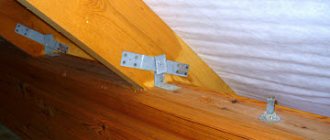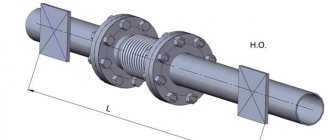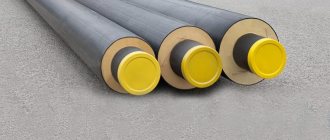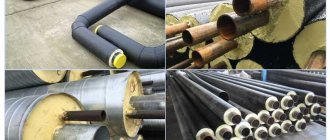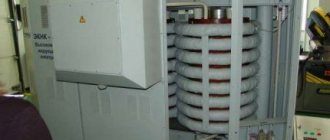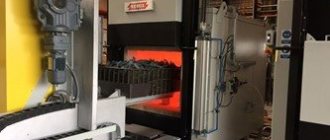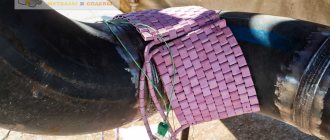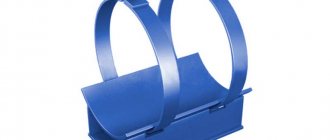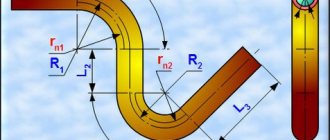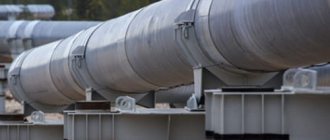Supports are integral elements of the entire system. They are designed to move the system if necessary, as well as to flexibly fix it in the designed position in order to minimize drift and extend its service life. In some cases, these system elements are used to reduce vibrations and also regulate stress in the pipeline itself.
- Types Movable
- Fixed
Types
Today, industry produces various types of supports used in industries such as energy, gas and oil production, heat and water supply, industry, etc.
There are several types of supports.
Movable
Designed to absorb vertical loads exerted by a loaded pipeline. Also used to evenly distribute temperature deformations. Depending on their functional purpose, movable pipelines are classified as follows:
- Roller
- Clamp
- Sliding
- Guides
- Spring
- Ball
Fixed
They are steel pipes with a steel stand. Designed to fix underground or above-ground masonry structures in certain places. Such products can reduce pressure, vibration or stress that occurs as a result of temperature changes. They are the ones most often installed to secure the pipeline in the northern regions.
What is the purpose of fixed supports?
Such structures for fixing pipes are required mainly in cases where significant loads act on the main line - the weight of the transported media, external influences. Fixed pipeline supports are designed to hold a section of pipes in a specific position and prevent it from moving or oscillating in any direction - horizontal, vertical, diagonal.
It is this type of supporting structures that can absorb loads. Transferring them to the foundation, and then to the ground. Among the loads that can be leveled by fixed pipeline supports:
deformation processes caused by temperature changes; pulsation caused by the movement of transported media; vibration from nearby highways and railways, the operation of special equipment; pressure surges inside pipe cavities.
Such support elements are used both during the installation of above-ground pipelines and during the assembly of underground pipelines for transporting liquids and gases. They are equally effective in preventing the influence of loads from various factors on both types of pipeline structures.
Installation of supports. Peculiarities
When installing pipeline structures, fixed supports are often used. They perceive significant forces, therefore, increased demands are placed on their strength and stability. Otherwise, rupture of welding seams and shut-off valves is inevitable. The designs of fixed supports are different. Which type will be used depends on the magnitude of the axial force exerted on the part.
Installation of fixed supports is carried out on metal structures. They are embedded directly at the installation site. The parts conditionally divide the pipeline into sections; bellows expansion joints are installed between the supports. Their main function is to minimize pipeline deformation under the influence of temperatures.
The fixed supports are welded to the support platforms and secured to the pipe using clamps. For more reliable fixation, thrust plates are welded to the supports close to the ends of the clamp. Compensation gaps of 1.5 millimeters must be left between the clamps and supports. In order to protect the pipe from corrosion, a gasket made of aluminum sheet is placed between it and the support. The installation of sliding supports is carried out taking into account thermal changes on each section of the pipe line. Based on this, they should be mounted with a slight axial offset. The offset percentage is specified in the project.
Main characteristics and purpose
A fixed support is a steel load-bearing element that bears the main load of the pipeline. Fixation on supports counteracts the longitudinal and transverse displacement of the steel flanges of the communications. The PPU shell and galvanization protect the NOP from mechanical influences. To additionally protect the structure from the destructive effects of moisture, thermal shrink tape is used.
Advice! When purchasing supports, ensure compliance with standards and certification!
Fixed supports in polyurethane foam are produced in several varieties, in accordance with GOST standards. According to the standards described in the documents, NOP is produced with a diameter ranging from 32 to 1420 mm.
After being planted in the heating main, standardized products are concreted on a reinforced base, so fixed supports are often called “dead”, that is, planted “tightly”. The standards for the production of this denomination are described in detail:
- OST 36-94-83;
- GOST 30732-2006;
- GOST 14911-82.
To manufacture fixed supports for heat supply pipes in polyurethane foam, different materials are used:
- hot rolled steel sheet;
- steel billet (pipe);
- centralizer;
- thermal tape;
- polyurethane foam (PPU) for the shell;
- shell (insulation) galvanized.
The support can be made of steel - ordinary and stainless
NOP is also available with or without thermal insulation. There are also options for laying the pipeline:
- overhead pipeline;
- underground ductless communications in PPU.
Attention! As waterproofing for supports under pipes in polyurethane foam insulation for channelless underground installation, standardization prescribes a shell made of polyurethane foam (or polyethylene). And for LOP with above-ground installation, a galvanized shell is used.
The length of sections of the heating main between fixed supports is determined according to standards that take into account the parameters of compensators. They are installed between fixed supports to dampen temperature changes in the pipe insulation. The pipeline is fixed at several points on each section; for this purpose, reinforced concrete frame elements are used during installation.
Distances between them
Correct placement of supports on pipeline sections is a very important criterion. This directly depends on the magnitude of the temperature forces and the load in the pipe. Minimizing the voltage in the heating main is a decisive factor for increasing the service life of the system as a whole. Therefore, the project must clearly indicate the location of the products, as well as calculate the expected loads on them.
Depending on the diameter of the pipe, the distance between the products varies.
| Pipe diameter (cm) | Distance (m) |
| 10 | 80 |
| 15 | 100 |
| 20 | 120 |
| 25 | 130 |
| 30 | 150 |
The distances given in the table are recommended mainly for underground channel pipelines. In the case of overhead installations, distances are determined according to calculations. To calculate indicators, you can use summary tables from the reference book “Design of Heating Networks” A. A. Nikolaev.
Features of installation on the heating main
Fixed stabilizers for heat supply systems are produced in two versions: for underground and above-ground operation. The placement of clamps in underground utilities is necessary to absorb overloads that occur when soil layers are displaced.
The uniform arrangement of support elements along the entire length of the heating main reduces vertical and linear loads on the pipeline branch. Structural components are installed in front of heating equipment, bellows corrugated pipes and fittings for main facilities. They help prevent temperature effects on the above devices.
When installing, the supports are fixed into reinforced concrete frames on those line segments that are marked in the technical design.
Laying systems underground requires placing the pipes and the supporting elements themselves in a polyethylene sheath. It provides thermal insulation protection for engineering structures, reducing heat losses in communications.
The number of clamps is specified in the technical documentation. Calculation of the optimal distance between them is an important step in the design of civil and industrial facilities. At the same time, engineers take into account the throughput and length of the highway, and take into account the instructions of building codes and regulations. Thus, SNiP 2.09.03.-85 defines a minimum step of 6 meters (a multiple of three) when designing industrial communications, including stabilizers for pipeline branches. These dimensions change when the route crosses railway and road communications and approaches different buildings.
Normative base
The manufacture and installation of the product is regulated by a number of GOSTs and SNiPs.
When installing parts, we are guided by SNiP 3.05.05 - 84, which clearly states permissible errors and deviations from the design.
In particular, the deviation of the location of the part for a pipeline laid indoors should not exceed +-5 millimeters, and +-10 millimeters for supports installed on external pipe lines. The permissible slope, according to these standards, is 0.001, unless otherwise provided by the project. There are also requirements for the location of supports relative to welded joints - at a distance of 5 centimeters or 20 centimeters for water supply and heating network pipes. https://ohtaspb.ru/articles/krepleniya_truboprovodov_po_sposobu_primeneniya/
Classification
Fixed supports for polypropylene pipes are divided into separate groups depending on what raw materials are used for manufacturing. Kinds:
- With electric welded pipes, which are insulated with polyurethane foam. Manufactured according to GOST 10704, 10705, 10706.
- With seamless pipes and insulated with polyurethane foam.
- Parts used for the manufacture of gas and oil pipelines are produced in accordance with GOST 20295. They have welded pipes and polyurethane foam insulation.
- With seamless heat-deformed and cold-deformed pipes. Manufactured in accordance with GOST 8732, 8734. They have polyurethane foam insulation.
- Parts used for the manufacture of pipelines for the petrochemical and oil refining industries. Manufactured on the basis of GOST 550. Covered with polyurethane foam insulation.
- Parts with welded pipes.
The polyethylene protective shell is the main element, without which the part cannot be put on sale or used.
If there is no protective polyurethane foam layer on the structure, the part will quickly become unusable due to the formation of rust. In addition, parts without polyurethane foam are not used to assemble hot water pipelines.
What is a fixed support in polyurethane foam insulation?
Important! All supports used in construction comply with GOST, OST or TU. There is a standard for different climatic zones, pipe diameters, types of supports and operating conditions. It is important to choose the right support, taking into account all its characteristics, otherwise the structure will not be strong.
Supports with polyurethane foam (PPU) are used for the construction of heating mains and water pipelines. They not only withstand large temperature fluctuations between the indoor and outdoor environments, but also have thermal insulating properties.
The fact is that movable hinged or sliding structures can shift under the influence of extremely hot water and steam. Fixed supports are more durable; they can withstand both high temperatures and high pressure.
They include:
- Steel billet, i.e. directly the pipe through which the liquid moves.
- Hot rolled steel sheet. One of the external parts gives the structure strength.
- Centralizer. There must be at least two of them. Centralizers are used at the junction of the supports with the outlet and supply pipes. They are responsible for tightness.
- Thermal tape. It is used for thermal insulation, which is most important for heating pipes and hot water pipes.
- Polyurethane foam. It is widely used as a coating for underground pipelines, which helps to extend the life of the fixed support.
- Galvanized shell. This is the outer layer of the above-ground fixed support, which serves as its insulation.
All the main characteristics of fixed supports are encrypted in their names. It looks like this:
- The presence or absence of a seam: w, b/w, respectively;
- Metal: St – steel, C – zinc;
- Diameter and section size: the first two digits separated by an “x” sign;
- Support size: second two digits separated by “x”;
- Region of operation (depending on thermal insulation): 1 - middle zone, 2 - north;
- Materials used for insulation: in this case, polyurethane foam.
We recommend that you read: Choosing the best pipes for a heating system
Advantages of fixed supports with polyurethane foam
PPU or polyurethane foam is a synthetic chemical compound obtained from petroleum products. This substance belongs to the category of gas-filled plastics. PPU can be hard or soft. The latter are used for the production of foam rubber and fillers for upholstered furniture. Rigid polyurethane foam is more durable and has better insulating properties; it is used in the construction of pipelines.
Polyurethane foam has a very low thermal conductivity coefficient and almost does not allow steam to pass through. Thus, the hot water in the pipe remains hot regardless of the ambient temperature. In addition, polyurethane foam is a waterproofing agent. It does not allow water to pass through and ensures the tightness of the fixed support.
An undeniable advantage is the ease of application of polyurethane foam. The fact is that the substance has high adhesion to any materials, that is, it has the ability to form strong adhesion. This property allows it to be applied in an even layer to the support frame.
This is interesting! Hard polyurethane foam retains not only heat, but also cold. It is used for the production of industrial refrigerators. An excellent example of the high adhesiveness of polyurethane foam is polyurethane foam.
Supports without polyurethane foam are more susceptible to corrosion. Their service life is significantly reduced. The joints between supports and pipes deteriorate especially quickly. In addition, non-insulated supports are not suitable for the construction of heating pipelines and hot water pipelines.

